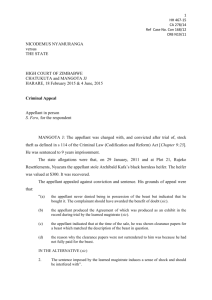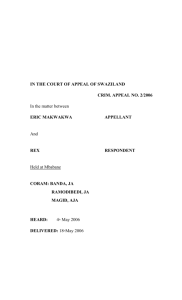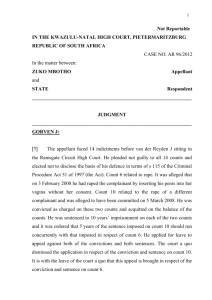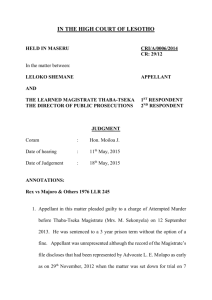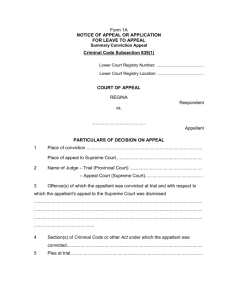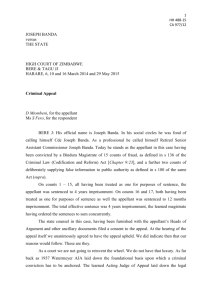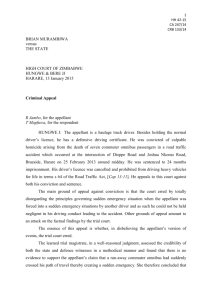HH 302-15
advertisement
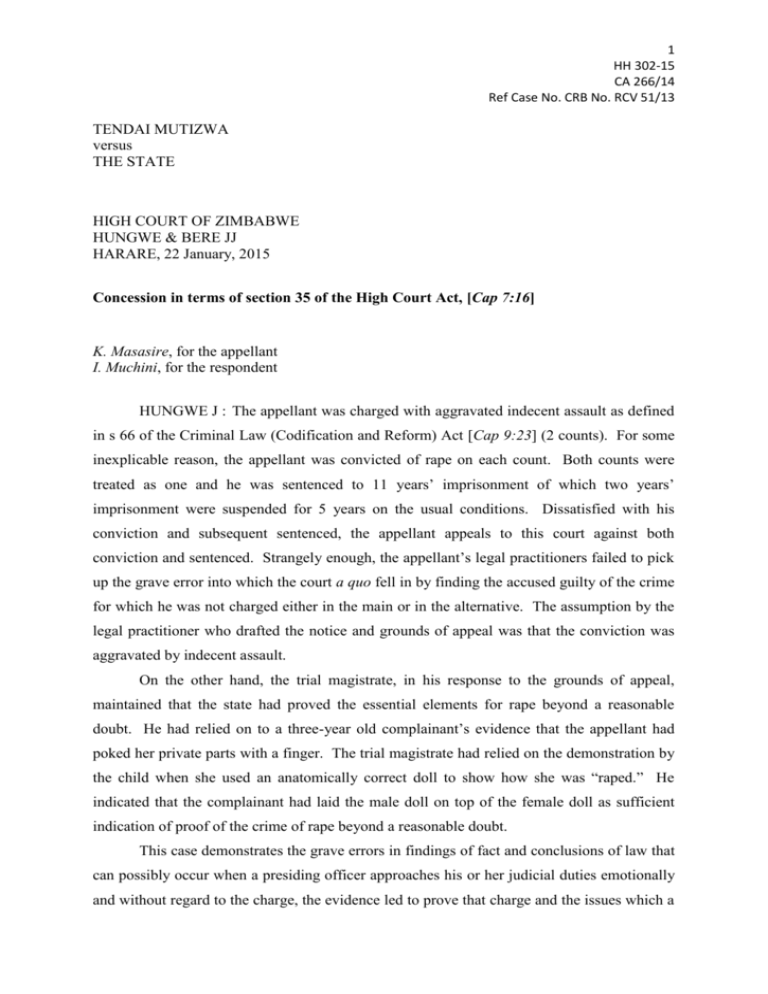
1 HH 302-15 CA 266/14 Ref Case No. CRB No. RCV 51/13 TENDAI MUTIZWA versus THE STATE HIGH COURT OF ZIMBABWE HUNGWE & BERE JJ HARARE, 22 January, 2015 Concession in terms of section 35 of the High Court Act, [Cap 7:16] K. Masasire, for the appellant I. Muchini, for the respondent HUNGWE J : The appellant was charged with aggravated indecent assault as defined in s 66 of the Criminal Law (Codification and Reform) Act [Cap 9:23] (2 counts). For some inexplicable reason, the appellant was convicted of rape on each count. Both counts were treated as one and he was sentenced to 11 years’ imprisonment of which two years’ imprisonment were suspended for 5 years on the usual conditions. Dissatisfied with his conviction and subsequent sentenced, the appellant appeals to this court against both conviction and sentenced. Strangely enough, the appellant’s legal practitioners failed to pick up the grave error into which the court a quo fell in by finding the accused guilty of the crime for which he was not charged either in the main or in the alternative. The assumption by the legal practitioner who drafted the notice and grounds of appeal was that the conviction was aggravated by indecent assault. On the other hand, the trial magistrate, in his response to the grounds of appeal, maintained that the state had proved the essential elements for rape beyond a reasonable doubt. He had relied on to a three-year old complainant’s evidence that the appellant had poked her private parts with a finger. The trial magistrate had relied on the demonstration by the child when she used an anatomically correct doll to show how she was “raped.” He indicated that the complainant had laid the male doll on top of the female doll as sufficient indication of proof of the crime of rape beyond a reasonable doubt. This case demonstrates the grave errors in findings of fact and conclusions of law that can possibly occur when a presiding officer approaches his or her judicial duties emotionally and without regard to the charge, the evidence led to prove that charge and the issues which a 2 HH 302-15 CA 266/14 Ref Case No. CRB No. RCV 51/13 court is ordinarily called upon to adjudicate upon in the case. The two counts specifically charge the appellant with inserting his finger into the complainant’s vagina. That is the gravamen of the aggravated indecency alleged in the charged. How the court could possibly open its reasons for judgment with the announcement that the appellant faced two counts of rape escapes all logic! The trial magistrate proceeded to condemn the shoddy investigations by the police stating that this could loose the case against the appellant when the complainant’s mother was repeatedly turned away thereby allowing the evidence of rape to disappear. He then justified the finding by the medical professionals that there was no evidence of penetration by concluding that this was because of the passage of time due to the police turning away the complainant’s mother on several occasions. Why the learned magistrate came to this conclusion is difficult to explain. Probably his mind was decidedly in favour of a finding that the minor was raped, out of sympathy for the complainant and derision for the police. That is a wrong approach to the duties of a trier of fact. There was just no evidence of penetration per vagina by the penis. The child says a finger was used. The doctors did not see evidence of that penetration. But the court took the claim by the complainant’s mother that the vaginal orifice was wider than usual as fact and found corroboration of this fact in the presence of a black spot in the child’s privates. As I pointed out, the basis of such findings were totally flawed as there were other reasonable inferences arising from the presence of the black spot. One piece of evidence which ought to have put the court on the alert was the claim by the child that appellant had finished with her when her mother called her on the second count where she claimed the poking occurred outside the bed-room and that if the mother was clever she could have peeped through the window and would have seen him in the act. If indeed this occurred, why did she not alert her mother whom she knew to be inside the house? Clearly, complainant was “clever”. She could equally have been suggestible regarding what she would say in court. This possibility was not excluded. Complainant’s mother has an interest to serve and her evidence ought to have been regarded with caution. The trial court ought to have warned itself of the real possibility that she was bent on speaking for her daughter and sought for corroboration of her evidence in that regard. See S v Banana 2000 (1) ZLR 607 (SC) The magistrate’s task was to assess the evidence led against the appellant in an effort to prove the crime charged, not whatever crime the court would have preferred. Its duty was 3 HH 302-15 CA 266/14 Ref Case No. CRB No. RCV 51/13 to assess the evidence proffered by the appellant in his defence dispassionately, without unrestrained scepticism, giving him the benefit of the doubt where it was due and making reasonable inferences both in his favour and against him as the evidence reasonably directed him to do. He would have been guided, when writing his judgment to consider only those facts found to have been proved and would have refrained from making unjustified and speculative conclusions which were not supported by the evidence on the record. The learned trial magistrate failed to do so. He fell into serious error, hence his conviction for an offence which the state never preferred or charged. For this reason alone, the conviction cannot stand. The concession by the state was well taken. In light of the above the appeal is allowed. The conviction is quashed and the consequent sentence is set aside. The verdict of the court a quo is altered to read as follows: “The accused is found not guilty and is acquitted.” BERE J agrees ……………………. Musoni Law Chambers, appellant’s legal practitioners National Prosecuting Authority, respondent’s legal practitioners
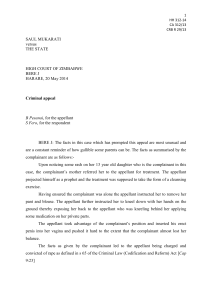

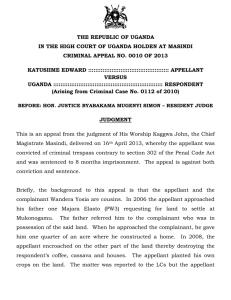
![(CA 177/2007) [2008] NAHC 7](http://s3.studylib.net/store/data/008805901_1-42577a9ec9ead416cded11509a08b1f1-300x300.png)
